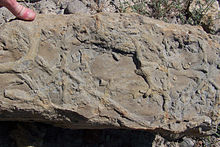Main articles: fossil and fossilisation
Among the three major types of rock, fossils are most commonly found
in sedimentary rock. Unlike most igneous and metamorphic rocks,
sedimentary rocks form at temperatures and pressures that do not destroy
fossil remnants. Often these fossils may only be visible under magnification.Dead organisms in nature are usually quickly removed by scavengers, bacteria, rotting and erosion, but sedimentation can contribute to exceptional circumstances where these natural processes are unable to work, causing fossilisation. The chance of fossilisation is higher when the sedimentation rate is high (so that a carcass is quickly buried), in anoxic environments (where little bacterial activity occurs) or when the organism had a particularly hard skeleton. Larger, well-preserved fossils are relatively rare.
Burrows in a turbidite, made by crustaceans, San Vincente Formation (early Eocene) of the Ainsa Basin, southern foreland of the Pyrenees
As a part of a sedimentary or metamorphic rock, fossils undergo the same diagenetic processes as does the containing rock. A shell consisting of calcite can, for example, dissolve while a cement of silica then fills the cavity. In the same way, precipitating minerals can fill cavities formerly occupied by blood vessels, vascular tissue or other soft tissues. This preserves the form of the organism but changes the chemical composition, a process called permineralization.[20][21] The most common minerals involved in permineralization are cements of carbonates (especially calcite), forms of amorphous silica (chalcedony, flint, chert) and pyrite. In the case of silica cements, the process is called lithification.
At high pressure and temperature, the organic material of a dead organism undergoes chemical reactions in which volatiles such as water and carbon dioxide are expulsed. The fossil, in the end, consists of a thin layer of pure carbon or its mineralized form, graphite. This form of fossilisation is called carbonisation. It is particularly important for plant fossils.[22] The same process is responsible for the formation of fossil fuels like lignite or coal.
Primary sedimentary structures
Sedimentary rocks are laid down in layers called beds or strata. A bed is defined as a layer of rock that has a uniform lithology and texture. Beds form by the deposition of layers of sediment on top of each other. The sequence of beds that characterizes sedimentary rocks is called bedding.[23][24] Single beds can be a couple of centimetres to several meters thick. Finer, less pronounced layers are called laminae, and the structure it forms in a rock is called lamination. Laminae are usually less than a few centimetres thick.[25] Though bedding and lamination are often originally horizontal in nature, this is not always the case. In some environments, beds are deposited at a (usually small) angle. Sometimes multiple sets of layers with different orientations exist in the same rock, a structure called cross-bedding.[26] Cross-bedding forms when small-scale erosion occurs during deposition, cutting off part of the beds. Newer beds then form at an angle to older ones.
The opposite of cross-bedding is parallel lamination, where all sedimentary layering is parallel.[27] Differences in laminations are generally caused by cyclic changes in the sediment supply, caused, for example, by seasonal changes in rainfall, temperature or biochemical activity. Laminae that represent seasonal changes (similar to tree rings) are called varves. Any sedimentary rock composed of millimeter or finer scale layers can be named with the general term laminite. When sedimentary rocks have no lamination at all, their structural character is called massive bedding.
Graded bedding is a structure where beds with a smaller grain size occur on top of beds with larger grains. This structure forms when fast flowing water stops flowing. Larger, heavier clasts in suspension settle first, then smaller clasts. Although graded bedding can form in many different environments, it is a characteristic of turbidity currents.[28]
The surface of a particular bed, called the bedform, can be indicative of a particular sedimentary environment, too. Examples of bed forms include dunes and ripple marks. Sole markings, such as tool marks and flute casts, are groves dug into a sedimentary layer that are preserved. These are often elongated structures and can be used to establish the direction of the flow during deposition.[29][30]
Ripple marks also form in flowing water. There are two types of ripples: symmetric and asymmetric. Environments where the current is in one direction, such as rivers, produce asymmetric ripples. The longer flank of such ripples is on the upstream side of the current.[31][32][33] Symmetric wave ripples occur in environments where currents reverse directions, such as tidal flats.
Mudcracks are a bed form caused by the dehydration of sediment that occasionally comes above the water surface. Such structures are commonly found at tidal flats or point bars along rivers.




No comments:
Post a Comment